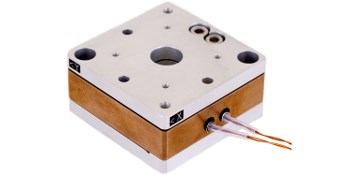Cryogenic environments below −150 °C have tough requirements on materials and equipment in general working under those conditions. Piezo actuators are no exception here. Some metals get brittle if temperatures decline and the risk of fractures increases and therefore the life expectancy of the actuator decreases. High thermal conductivity of the used materials is fundamental in operating a piezo actuator in such environments because often times cryogenic setups are placed in vacuum and heat only can be channeled away via the body of the actuator itself.
A piezo actuator that functions under these extreme conditions needs special customization. Materials have to be thermally conductive so as not to change the performance of the actuator – especially dynamics, precision, and translation of the motion. An example of overcoming these challenges is the PXY 100 Cryo by piezosystemjena. It is constructed of thermal conductive copper–beryllium and aluminum. Since cryogenic temperatures often go hand in hand with UHV (Ultra High Vacuum), the PXY 100 Cryo had to be outfitted for vacuum use as well. The stage’s aluminum parts are therefore not anodized and cables are isolated by capton or teflon.


